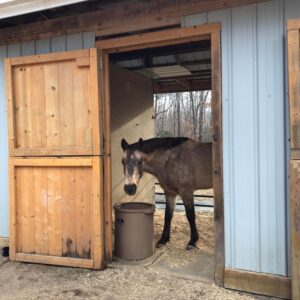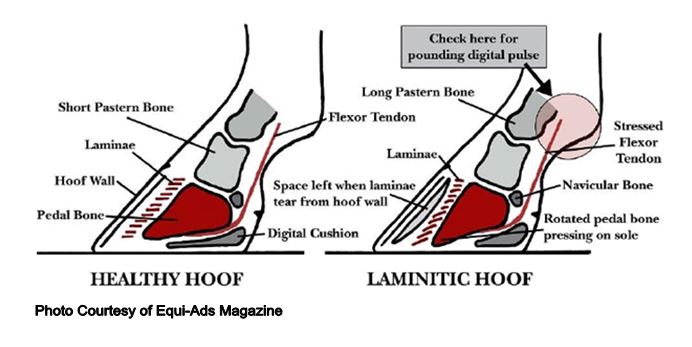Digestive Ailments
How Porta-Grazer Can Help
There are many digestive ailments that can be treated and or prevented simply by changing the method of feeding.
Below is a list of the many different ailments that
Porta-Grazer can help with.
Click the ailment below to open the drop down.
Click again to close the drop down.
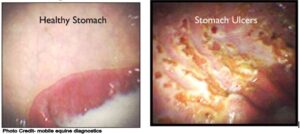
Health stomach vs With Ulcers
Balancing Calories and Volume
Ulcers can cause performance issues as well as bad stall habits Horses need access to forage 24/7 to keep their stomach acid buffered to prevent ulcers. But how do we provide forage 24/7 without the horse becoming fat? EASY! In order to maintain weight use a low calorie grass hay, such as Timothy, Teff or Bermuda. It's the calories IN the hay that needs regulated not the volume of hay. So, in order to give your horse the ability to keep that acid in check as nature intended, there needs to be a continuous supply of low calorie forage at all times.
Horses that are allowed to eat as much hay as they need are generally more relaxed and content. Therefore, they perform better. The horse is able to keep the stomach acid in balance. Which reduces vices such as wood chewing, pawing, racking their teeth on the stall etc.
What if I cant find low calorie hay?
Sometimes we don't have a choice on what we can find for hay. One option is using straw. Oat, wheat or barley straw. By mixing the straw in with your hay in the Porta-Grazer it adds more volume without adding much in the way of calories.
How does a Porta-Grazer help?
By putting low calorie forage in the Porta-Grazer your horse is able to graze in a more natural head down position. Which allows the jaw to slide into position for proper chewing.
The rotating pan lifts the bits of hay up thru the holes and holds it so the horse is able to size and tear each bite. Same as if in pasture. Therefor providing more chew time that produces more saliva to buffer the stomach acid.
Once the horse is self regulated it will eat what it needs to buffer the acid and walk away. Then as the acid builds it will come back again to graze as needed.
Horses naturally graze 18-20 hours a day.
Using a Porta-Grazer also prevents wasted hay, and keeps the hay off the ground and out of the mud, sand, dirt, snow etc.
When hay is baled the process creates dust, which adheres to the hay and is compressed into the bale.
Therefor when the hay is eaten in large compressed bites or when fed on the ground dust and sand particles are ingested. These particles settle in the digestive tract which can cause a blockage that is usually fatal if not treated immediately.
Colic is the largest cause of premature death in equines.
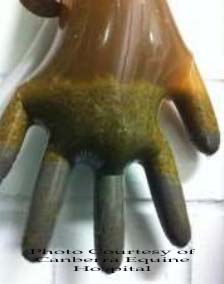
How does using a Porta-Grazer help?
How does using a Porta-Grazer to prevent sand colic? The pan is designed to lift and hold the bits of hay up to the horse. This allows the horse to size and tear off each bite. Which causes the dust, sand and dirt to be shaken loose and work its way to the bottom of the barrel. There it is collected in a trough out of the horses reach to be discarded later. Little to no feed is dropped to the ground to be contaminated with foreign materials and ingested.
When feeding on the ground sand and dirt particles can be ingested.
Horses do not eat naturally off of the ground, they eat the tops of plants that grow from the ground.
How using a Porta-Grazer can help prevent impaction colic. Porta-Grazer allows the horse to size and tear off each bite same as if they were in pasture.
A horse’s food must be moist when leaving the stomach in order to flow smoothly and allow the nutrients to be absorbed by the digestive system. This moisture is obtained from the saliva created while chewing.
When pasture is not an option many people just toss out some flakes of hay. When the horse can't size their bite they end up with a big mouthful that doesn't get chewed properly. Less chewing means less saliva is getting mixed in. Low moisture content will lead to intestinal impaction colic.
This is especially true for ration fed horses that stand for hours with no forage. Horses do not have a gallbladder. The stomach acid runs 24/7. When they are finally given hay they try to eat as quickly as possible, in an effort to buffer the stomach acid. They don't spend as much time chewing. And will swallow a rather dry bolus of hay. This can lead to impaction colic.
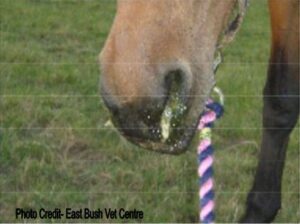
Signs of choke
Choke
Choke in horses can be scary. The most obvious signs are discharge of saliva and feed material from the nostrils or mouth. Also apparent difficulty in swallowing. When choking some horses will panic and make repeated unsuccessful efforts to swallow, cough or 'gag' as though trying to clear something from the back of the throat. Although many cases clear on their own, if you think your horse has choked, call your veterinarian immediately.
Most Common Cause of Choke
The most common cause of choke is swallowing food or other material that is either too dry or coarse. Not chewing properly can cause the food to not be mixed well with saliva so they swallow it too dry. This can cause it to be slowed or stopped as it goes down the esophagus. Any condition that interferes with the horse's ability to swallow such as injury to the neck or esophagus can also predispose to choke.
Not Chewing Thoroughly
Hay is pressed into clumps when it is processed forcing the horse to take unnaturally large bites. These large mouthfuls cannot be sufficiently chewed and adequately lubricated to be easily swallowed. Using a Porta-Grazer allows the horse tears off each bite sizing it to his particular needs. He is then able to chew and thoroughly lubricate each bite before swallowing.
Preventing Choke When Feeding Pellets
Some horses can't have hay. Their forage is provided in pellet form. However a lot horses tend to grab huge mouthfuls at time. This can lead to choke due to not chewing enough to sufficiently mix in adequate amounts of saliva to lubricate the pellets before swallowing.
To help prevent this Porta-Grazer has a pellet pan for the XL and Mini model that only allows a few pellets at a time to roll to the top. This gives the horse ample chew time.
How Porta-Grazer Can Help Prevent and Treat Laminitis
- Porta-Grazer™ can help prevent and treat laminitis by simulating grazing at a natural pace while not allowing sugar level spikes.
- When dealing with laminitis or founder many people try to restrict the horses volume of forage (in an effort to reduce the sugar / calories), which can lead to ulcers. Instead of reducing the amount of hay you need to regulate the sugar/calories IN the hay you are feeding.
- Porta-Grazer allows the horse to graze 24/7 buffering the acid naturally while giving you a way to regulate the calories/sugar to prevent or treat laminitis. Using low calorie grassy hay allows the volume the digestive system needs without the sugar/calories they don't need.
- The rotating pan prevents the horse from picking thru the hay. They can only get what comes to the top instead of searching thru and picking out the sugar first. This keeps the sugar intake at a constant safe natural level with no spikes in sugar levels. In most cases using a Porta-Grazer will eliminate the need to soak the sugar from the hay.
Using Porta-Grazer to Soaking Hay
Sometimes it is necessary to to soak the forage for immediate help with treatment of laminitis or to remove excess sugars. When you reduce the sugar/ calories it allows the horse the ability to free feed therefor preventing the horse from getting ulcers and other digestive issues while treating the laminitis.
Since all Porta-Grazer models have a built in drain plug to make soaking easy. No more messy wet hay to deal with. Simply load the Porta-Grazer with dry forage per directions, fill with water, soak, then drain the water out and give it to the horse.
Similar to human type II sugar diabetes, you can safely eat sugar, but a bite an hour not a candy bar an hour.
Maintaining your horses weight
All horses require forage 24/7 regardless of size or breed. Horses do not have a gall bladder so the stomach acid runs 24/7. When no forage is available the stomach acid builds up with no way for the horse to buffer it. Which can lead to ulcers and bad stall habits- such as wood chewing, pawing, and more.
A lot of people say some horses or certain breeds are "easy keepers" or "piggy eaters". So they try to reduce the amount of hay in an effort to maintain the weight. When you ration out small amounts of hay a few times a day to limit the calorie intake this creates a feast and famine routine for the horse. The stomach acid builds between the "meals". Therefor, they tend to be more aggressive eaters when you bring a portion of hay. All they are trying to do buffer that stomach acid.
How to free feed without weight gain
So how do you maintain your horses weight, while still giving them the amount of forage their digestive system needs?
By regulating the calories IN the hay.
At first, when introducing your horse to free feeding they may seem to spend nearly all their time at the feeder. However, once the novelty of the all-you-can-eat buffet wears off, a normal horse will reduce its hay consumption to an amount needed to maintain a normal body condition.
Horses with a higher work load usually require more calorie intake than a horse that has a more "relaxed" life style. However, both types still need forage available 24/7 in order to keep their digestive system working properly and to prevent ulcers.
By free feeding a low calorie type hay such as timothy or teff you can meet the horses digestive needs, without the excess calories they don't need. You are spreading the same amount of calories over a longer period. A higher calorie hay can be used for those that need more calories while maintaining a low calorie hay for the ones who don't need extra calories.
For example- A mini requires very little in the way of calories. They seem to get fat just by breathing air. Yet their digestive system still works the same as a larger breed horse. By providing a low calorie hay even these pint size horses can still graze all day and night and maintain their proper weight.
If weight gain or insulin resistance / laminitis is a concern, have the hay analyzed for sugar and starch content. (It should be less than 10%).
Is your horse "fat" or has a "hay belly"? Here is a great article by Juliet Getty PhD- Does a Hay Belly Mean My Horse is Fat?
How using a Porta-Grazer helps
By using a Porta-Grazer it allows the horse to control the size of his bites. Same as in pasture. The rotating pan lifts and holds bits of hay up to the horse so it can size and tear of each bite. Ample saliva is mixed with the forage as it is chewed. When thoroughly salivated forage enters the stomach it begins to buffer the painful stomach acid. Which balances the pH and creates comfort. When the pH is in balance he will quit eating until the acid builds up again. Then he will eat to bring it back to balance. That is the grazing routine you see when horses graze mature pasture.
Feeds that are high in sugar (grains for example) interfere with the pH balancing process.
What if my horse can only have pellets?
Horses that cannot chew hay for whatever reason can still be free fed by using low calorie type grass hay pellets. The pellet pan only allows a few pellets at a time to come to the top. This allows the horse the ability to have plenty of chew time while still maintaining their weight.
Related topics you may find helpful
Forage deprivation can make your horse stay fat.

Notice the "heave line"
COPD in horses, also called heaves, is characterized in horses by chronic coughing, an increased respiratory rate, low tolerance for exercise, and also forced abdominal breathing which can cause a "heave line" as pictured above.
While searching through the hay horses may inhale dangerous amounts of dust, pollens and mold which can lead to an allergic reaction and COPD. Management of affected horses is heavily reliant on minimizing the exposure to these irritants.
How feeding in a Porta-Grazer can help
When using a Porta-Grazer the rotating pan lifts the hay up to the horse. This allows the horse to tear off a bite without being able to sort thru the hay. Each bite is pulled directly into the mouth. The dust, sand, pollens and molds are shaken loose. Which works its way to the bottom of the barrel. There it is collected in a trough out of the horses reach to be discarded later.
You can also rinse or soak the hay in the Porta-Grazer. All models have a drain plug.
Temporomandidular joint syndrome in horses may present symptoms such as -
- Head tossing
- Resisting bridling, not accepting the bit, or becoming head shy
- Changes in the way the horse carries its head and or tilting the head.
- Less of an appetite or difficulty chewing and eating, including quidding.
- Sticking the tongue out
- Performance issues such as difficulty stopping or turning.
- More severe performance issues such as refusing to move forward, backing up, rearing, bucking, or spooking.
Some of these symptoms can also indicate other issues such as ulcers, arthritis of the neck, training problems, or other ailments . Its best to confirm with a veterinarian if the symptoms indicate TMJ.
How using a Porta-Grazer can help
Eating from elevated hay racks and nets can also cause TMD (temporomandibar dysfunction) Because, not being able to tear his bites when eating hay the horse is forced to eat with his lips not incisors causing uneven wear to all dental surfaces, thus impairing the function of the TMJ (temporomandibular joint mechanism) which is vital to the horse’s health.
When using a Porta-Grazer the horse eats in a head down position. The horse is able to use their incisors to tear off each bite. With the head down while grazing the mandible is allowed to slide down and forward relaxing the TMJ muscles which allows for proper teeth contact
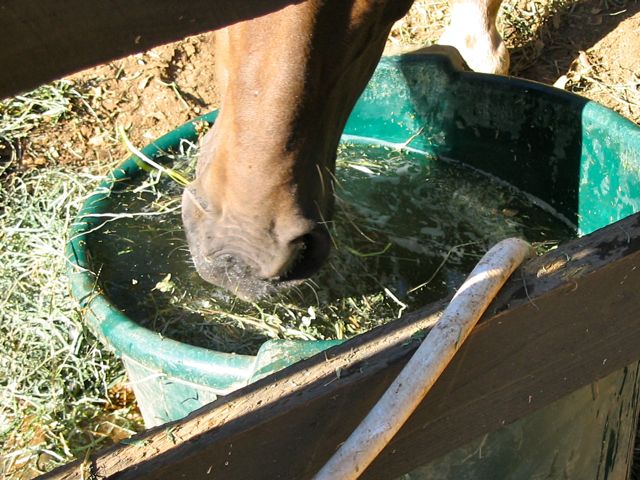
Dunking
Why does your horse dunk its hay in the water? You go out and there it is. The messy left over bits floating in the water trough.
Why do horses dunk?
Its much like when we take a bite of a cake that is rather dry... We struggle to get it down so we reach for something to drink. Once the cake is all nice and wet we are able to swallow it easier. THIS is what your horse is doing!
Hay has low moisture content. When the horse cant size its bite it can cause a large mouthful to be taken which can be hard to chew thoroughly to get enough saliva mixed in to lubricate it. When your horse dunks its hay in the water its actually doing itself a favor. By making the hay wet it is easier to get that big blob of hay down. Some will wave the hay around in the water separating it into more manageable bites. While this is not a bad thing for the horse as it helps prevent choke or impaction, it can be frustrating for owners who constantly have to clean the mess up.
How Porta-Grazer can solve both problems
By using a Porta-Grazer the horse is able to size and tear off each bite same as in pasture. This allows the horse to have smaller bites that can be thoroughly chewed. Which adds in enough saliva to lubricate each bite to facilitate easy swallowing.
WIN WIN for the horse who can now size each bite and for the owner who doesn't have to be cleaning out hay from the water trough.
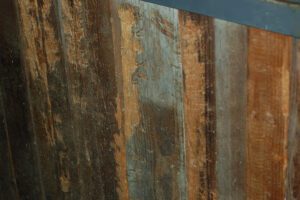
Wood chewing
Porta-Grazer can help with bad stall habits, misleadingly referred to as “Boredom”. Since horses do not have a gall bladder stomach acid is produced 24/7. When the stomach is empty of forage (This can be as soon as 20 minutes after finishing his meal), acid alone in the stomach without the alkalinity of food and saliva to buffer it causes discomfort and lead to gastric ulcers.
Many people try to maintain weight by ration feeding. Meaning giving a small amount and the horse has nothing available until the next "meal". However, when no forage is available the horse will do unnatural behaviors to create saliva to buffer the acid in an effort to soothe the pain. Behaviors may include cribbing, eating manure, destructive chewing, licking or constantly grazing the bare ground for anything that may be eaten. Many behaviors such as pawing, kicking walls, banging the feeder are ways to get your attention to bring forage, which relieves the pain. Horses will bolt their feed when forage is finally provided in an attempt to soothe the pain of an overly acidic stomach.
Did you know ration feeding can actually make your horse fat? Read this article by Juliet Getty PhD- How Forage Deprivation Keeps Your Horse Fat
How does Porta-Grazer help?
So how does Porta-Grazer help with these bad habits? Each bite is sized and thoroughly chewed saturating the forage with saliva and neutralizing the excess acid. Large bites of hay with small amounts of saliva will not bring the acid into ph balance and the horse will continue to eat until out of food. Small sized bites well saturated with saliva quickly bring the acid into pH balance. When in balance the horse will usually not continue to feed, unless the hay has high sugar content. By providing enough forage 24/7 to keep the stomach acid buffered the horse can calmly graze as needed.
Parasites
Parasites can be a burden on your horses health. Sapping the needed nutrients and cause the horse to loose weight or in worse case scenarios can cause and impaction colic.
When feed is dropped and or eaten from the ground where animals are kept there is a high likelihood that parasites will be ingested in higher than normal quantities. This will have an adverse effect on your horses health as will the chemicals used to combat an infestation.
Wen using a Porta-Grazer it allows the forage to be taken directly into the horse’s mouth in small bites preventing feed from being picked through and dropped to the ground.
By not exposing your horse to the parasites environment fewer chemicals will be needed to control infestation.
How you feed affects your horse
How you feed can affect your horses conformation. When the horse eats with its head in an upright position it hollows the back. Which transfers the body weight to the hind quarters. This will result in the hind legs being placed further back than normal. So stress is constantly being applied to the back and hocks. This can also cause neck issues from the constant twisting to get the forage. Also, dust, hay and debris can fall into the eyes.
Horses have a relaxed natural body position when grazing from the Porta-Grazer.
How eating in a natural position helps
When a horse eats with its head down it allows the jaw to slide forward to properly chew. The neck, back, hocks, are all relaxed and in a natural position. Which also allows the sinus to drain properly.
Porta-Grazer is a more natural way to feed
Porta-Grazer allows the horse to graze with its head down as nature intended. This natural stance pulls the topline into alignment and the hind legs into the correct weight bearing position relieving neck, back and hock stress. Having forage available at all times will also reduce a bulging “hay” belly.
